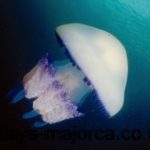Table of Contents
Jellyfish are invertebrates that present special cells used to capture prey and defend themselves.
These cells have a poisonous capsule inside.
When a prey or predator makes contact with the jellyfish, the capsule opens and the cells stick to them, injecting poison.
Our jellyfish sting remedies are good to know beforehand.
Jellyfish are usually transparent as they are 95% water, allowing them to camouflage easily.
Below you’ll find images and descriptions of the common types of jellyfish found around Majorca, Spain.
They usually live 20 to 40 miles from the coast where the water is saltier and warmer.
If it has been a dry winter and rainfall has been low, the water at the beach may be of similar salt levels, thus providing a favourable environment for jellyfish.
However, the main causes for an increase of jellyfish in an area are the marine currents and overfishing, especially when tortoises are captured, as these are the main jellyfish predators in the Mediterranean.
In Spanish, the word for jellyfish is medusa, like the mythical Greek monster with snakes for hair.
If you hear somebody saying that when you are in the sea or on the beach, be careful!
If you’re worried about jellyfish stings, try this jellyfish repellent sun cream.
Mediterranean Jellyfish
Fried Egg Jellyfish / Medusa Huevo Frito (Cotylorhiza Tuberculata)
Sting level: not very painful.
They are yellow and look like a fried egg, usually 17cm wide.
They are common in the Mediterranean during summer and autumn.
This type of jellyfish can sting and cause temporary itching but do not require medical assistance.
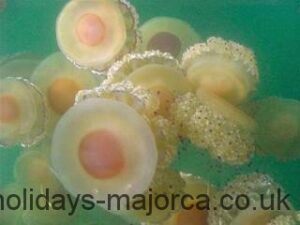
Common Jellyfish / Medusa Común (Aurelia Aurita)
Sting level: not very painful.
Round, like a cup, usually white with pink or blue tones and have long tentacles, they are normally about 25cm wide.
They are easy to find near the coast in Majorca. Contact causes irritation and itching.
Applying ice may reduce symptoms, but medical assistance is not usually required.

Compass Jellyfish / Medusa de Compases (Chrysaora Hysoscella)
Sting level: painful.
Looks like an umbrella, usually white and yellow, they are around 20cm wide.
They are not very common near the coast of Majorca but live in the Mediterranean Sea.
Causes an itching and burning sensation and can scar the skin for up to 3 weeks.
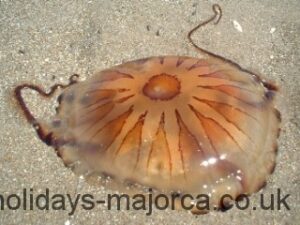
Shiff Arms Jellyfish / Aguamala (Rhizostoma Pulmo)
Sting level: painful.
They are one of the more beautiful types of jellyfish found in Majorca and are about 50cm wide.
They are bluish with a purple ribbon and have 8 tentacles, which if touched causes pain, but no other effects.
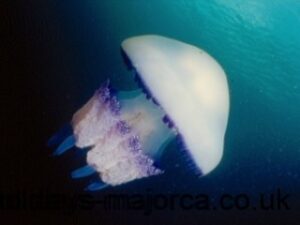
Pink jellyfish (Pelagia Noctiluca)
Sting level: painful and dangerous.
It is a 10cm fluorescent jellyfish, transparent with pink or purple tones.
It has 16 long tentacles that can cause pain, burning, nausea and muscle cramps.
They are not very common in Majorca, but if seen do not touch!
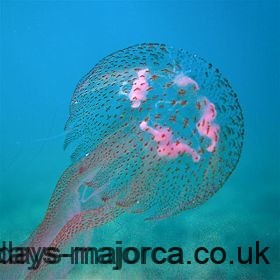
Portuguese Man o’War / Fragata Portuguesa (Physalia Physalis)
Sting level: very painful and extremely dangerous.
Not technically a jellyfish, but treated as one.
The most dangerous sea creature found in the Mediterranean, but are not usually found in Majorca during the summer season, as these are cold-water creatures.
It floats on the sea, has a purple colour and is about 10cm high.
Its tentacles can be 2 meters long and they are fast swimmers.
They can cause extreme pain, fever, burns to the skin and neurological shock.
Due to their dangerous nature, the Spanish Coastguard keeps watch for them and reports are issued on the local TV, radio and newspapers if they approach the coast.
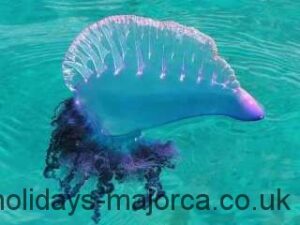
Purple Sail or Velella / Medusa Velero (Velella Velella)
Sting level: not harmful to humans.
As with the previous one, not technically a jellyfish, but treated as one.
With an approximate diameter of 6cm, they have a transparent stiff sail and their body is deep blue with circles.
It is a carnivorous species, catching their prey with its tentacles and are very difficult to spot.
They move by catching the wind on their sails.
Their venom is not harmful to humans.
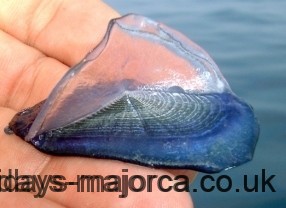
What to do if there are jellyfish at the beach?
As you can see, there are many types of jellyfish found in the Mediterranean around Majorca.
In most cases, you won’t come across any whilst enjoying the sea, but if you do:
- Do not get in the water, keep an eye on the shore too.
- If one jellyfish is spotted, there will probably be more around.
- Do not touch them even when they appear dead.
It takes 24 hours for the sun to deactivate its poison. - If stung:
- Do not scratch the skin with sand or a towel.
- Do not pour fresh water over the affected area.
- Apply ice for 15 minutes. Ice must be inside a plastic bag to avoid freshwater melting onto the affected area. If the area is still painful, seek medical attention.
Are the jellyfish in Mallorca poisonous?
Many of the jellyfish around Mallorca do inject poison when they come in contact with other animals, including humans.
This is more commonly referred to as being stung.
Typically, the sting is just painful with no long-term implications rather than lethal, however, people who are allergic should be very careful, as the stings could be lethal.
If you’re interested in Mallorca’s marine life, take a look at our guide to Mallorca’s coastal fish.

Mark Kaye is a travel writer and content creator living in Majorca, Spain. Originally from the UK, Mark moved to the island and quickly fell in love with Majorcan culture, food, and scenic landscapes. When he’s not busy writing detailed guides about Majorca’s top tourist attractions and hidden local gems, you can find him out exploring coastal trails or wandering the streets of Palma’s Old Town in search of his next great restaurant discovery.




